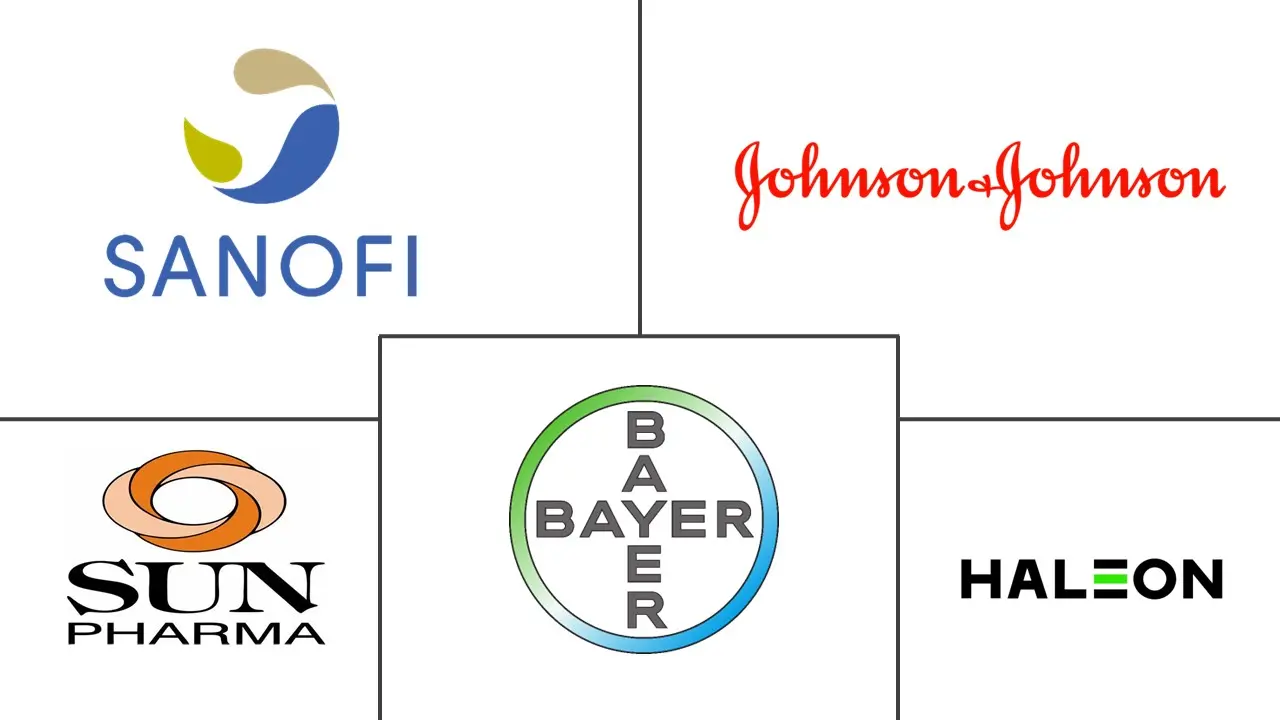Antacids Market Size and Share
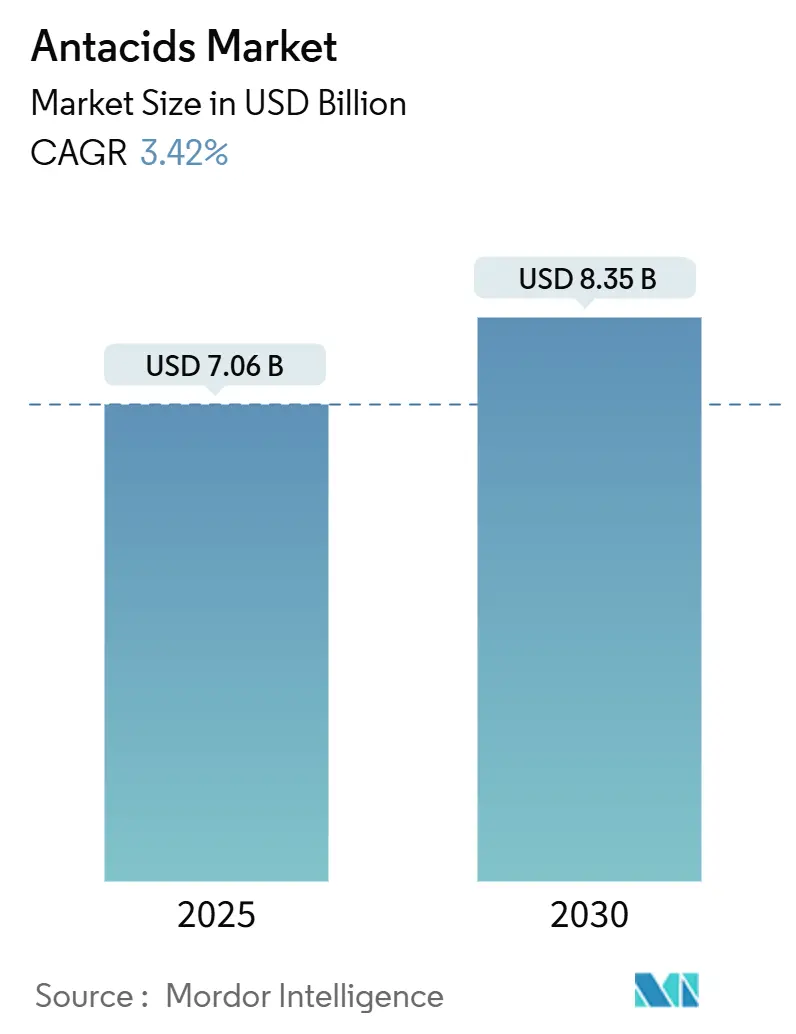
Antacids Market Analysis by Mordor Intelligence
The antacids market size is valued at USD 7.06 billion in 2025 and is forecast to reach USD 8.35 billion by 2030, advancing at a 3.42% CAGR. This growth pace reflects a mature competitive field in which conventional neutralizing products contend with proton pump inhibitors (PPIs) and potassium-competitive acid blockers (P-CABs). Demand stability rests on demographic forces, notably a rapidly expanding cohort of adults aged 65 and above who experience higher rates of gastroesophageal reflux disease (GERD) and related acid disorders. Consumption patterns also track the global spread of sedentary lifestyles and diets rich in processed foods, both of which raise reflux incidence. Retail pharmacies continue to anchor over-the-counter (OTC) availability, yet digital commerce is accelerating their reach by blending in-store service with app-based fulfillment. Meanwhile, formulation science is reshaping consumer expectations, as gummies, soft-gels, and alginate-based “raft” products move from novelty to mainstream, helped by improved taste-masking and controlled-release technologies.
Key Report Takeaways
- By formulation type: Tablets led with 25.56% of antacids market share in 2024, while gummies and chewable soft-gels are projected to post the fastest 5.67% CAGR to 2030.
- By active ingredient: Calcium carbonate held 38.54% of the antacids market size in 2024; alginate-based products are expected to grow at a 5.23% CAGR through 2030.
- By route of administration: Oral solid formats commanded 64.44% share of the antacids market size in 2024, whereas oral liquid forms will expand at a 6.12% CAGR over the forecast window.
- By indication: GERD accounted for 49.23% of antacids market share in 2024, yet heartburn is set to climb fastest at a 5.76% CAGR.
- By distribution channel: Retail pharmacies and drug stores combined for 44.67% revenue share in 2024 and are on track for a 6.55% CAGR, outpacing all other channels.
- By geography: North America retained 42.45% share of the antacids market in 2024, while Asia-Pacific is forecast to grow fastest at a 4.56% CAGR to 2030.
Global Antacids Market Trends and Insights
Driver Impact Analysis
| Driver | % Impact on CAGR Forecast | Geographic Relevance | Impact Timeline |
|---|---|---|---|
| Aging population and rising incidence of gastrointestinal disorders | +0.8% | Global, concentrated in North America & Europe | Long term (≥ 4 years) |
| Unhealthy dietary habits and sedentary lifestyles | +0.6% | Global, accelerated in Asia-Pacific urban centers | Medium term (2-4 years) |
| Over-the-counter accessibility and self-medication culture | +0.4% | North America & EU; expanding to emerging markets | Short term (≤ 2 years) |
| Expansion of retail pharmacy and digital commerce channels | +0.5% | Global, led by North America with Asia-Pacific catch-up | Medium term (2-4 years) |
| Rising healthcare expenditure in emerging economies | +0.3% | Asia-Pacific core; spill-over to Middle East & Africa | Long term (≥ 4 years) |
| Innovation in formulation and delivery technologies | +0.4% | Global, with R&D hubs in North America & Europe | Medium term (2-4 years) |
| Source: Mordor Intelligence | |||
Aging Population and Rising Incidence of Gastrointestinal Disorders
Higher life expectancy is pushing the prevalence of acid-related conditions upward. In the United States, 51.5% of Medicare beneficiaries carried a digestive diagnosis in 2024 compared with 24.2% on Medicaid, underscoring an age-skewed disease burden[1]American College of Gastroenterology, “Digestive Disease Burden 2024,” journals.lww.com. Physiologic shifts—such as reduced gastric buffering and drug-induced mucosal irritation—drive sustained purchases of antacid products among seniors. Polypharmacy complicates the picture; concurrent use of NSAIDs, anticoagulants, and corticosteroids heightens reflux and gastritis risk. Japanese cohort studies further signal nutritional trade-offs, noting that 16% of health-check participants took antacids and showed lower pre-albumin levels, hinting at protein absorption challenges. Together these trends support long-horizon volume growth in the antacids market.
Unhealthy Dietary Habits and Sedentary Lifestyles
Urban dietary patterns rich in fried foods, sugar, and carbonated beverages align with rising reflux incidence. Regional contrasts illustrate the effect: Turkey registered a 22.4% GERD prevalence, while China posted only 4.16%, a gap largely tied to eating habits and body-mass indices. Office-based work and reduced physical activity slow gastric motility and amplify stress-related acid secretion. In the United States alone, the annual direct cost burden of GERD now exceeds USD 10 billion, elevating OTC antacid use as a first-line defense. Co-morbid diabetes adds another layer; 73% of diabetic patients report bloating versus 67% in non-diabetics, creating cross-category demand for antacid solutions.
Over-The-Counter Accessibility and Self-Medication Culture
OTC sales in the United States surpassed USD 40 billion in 2025 and continue to expand above 3.5% annually as consumers prioritize convenience. FDA’s Additional Conditions for Nonprescription Use (ACNU) rule streamlines prescription-to-OTC switches, broadening shelf availability of acid-suppressing agents[2]FDA, “Additional Conditions for Nonprescription Use,” fda.gov. On average, U.S. residents buy 26 OTC items per year—far exceeding physician visits—making pharmacies an essential touchpoint for symptom-driven purchases.
Innovation in Formulation and Delivery Technologies
Algorithm-guided R&D pipelines are producing raft-forming alginates, 3D-printed pH-responsive matrices, and sodium-alginate capsules that release drug only when gastric pH drops. Akums’ sodium alginate–potassium bicarbonate chewable tablets have demonstrated clinically meaningful reflux relief. Similar advances in micro-encapsulation mute the chalky taste of calcium carbonate, unlocking gummy formats well-suited to pediatric and geriatric segments[3]RSC Pharmaceutics, “Taste-Masking Advances,” rsc.org.
Restraints Impact Analysis
| Restraints Impact Analysis | (~) % Impact on CAGR Forecast | Geographic Relevance | Impact Timeline |
|---|---|---|---|
| Growing adoption of proton pump inhibitors and H2 antagonists | −0.9% | Global, particularly in developed markets | Medium term (2-4 years) |
| Safety concerns related to chronic antacid consumption | −0.4% | North America & EU regulatory focus | Long term (≥ 4 years) |
| Fluctuating raw material prices and supply chain vulnerabilities | −0.3% | Global, most acute in Asia-Pacific raw-material hubs | Short term (≤ 2 years) |
| Strengthening regulatory oversight on OTC drug claims | −0.2% | North America, EU, and increasingly Asia-Pacific | Medium term (2-4 years) |
| Source: Mordor Intelligence | |||
Growing Adoption of Proton Pump Inhibitors and H2 Antagonists
Superior healing rates and 24-hour symptom suppression give PPIs and emerging P-CABs a pharmacologic edge. Vonoprazan achieved a 93% healing rate in erosive esophagitis trials compared with 85% for lansoprazole. Eisai’s prescription-to-OTC switch of rabeprazole (Pariet S) has extended advanced acid blockers into mainstream retail, eroding share for short-duration antacids. Japanese health-economic studies report lower three-year GERD costs when therapy begins with a P-CAB rather than a PPI, reinforcing the long-term shift.
Safety Concerns Related to Chronic Antacid Consumption
Litigation surrounding ranitidine underscores the market’s risk profile. GSK agreed to a USD 2.2 billion settlement covering roughly 80,000 Zantac cases in 2025. The FDA withdrew ranitidine products after detecting NDMA impurities, and it has tightened OTC monograph requirements for solid oral antacids. Clinical data linking extended antacid use to disrupted calcium and magnesium uptake are prompting clinicians to weigh benefit-risk profiles more carefully, potentially slowing chronic usage in favor of targeted regimens.
Segment Analysis
By Formulation Type: Gummies Drive Innovation Wave
Tablet forms remain dominant, with 25.56% of antacids market share in 2024, yet gummy and chewable soft-gel formats are rising at a 5.67% CAGR, redefining consumer expectations for taste and convenience. Single-dose portability and familiar confectionery textures draw first-time users, especially in the 18-35 demographic. Advances in polymer coating and micro-encapsulation have resolved longstanding bitterness issues, allowing higher drug loads without flavor compromise. Liquids and suspensions continue to serve pediatric and geriatric niches, benefiting from immediate bioavailability and ease of swallowing.
Competitive positioning now hinges on sensory experience as much as pharmacodynamics. Manufacturers are adding digestive enzymes, probiotics, or vitamin fortification to gummies, framing them as holistic digestive aids rather than reactive remedies. Scalable pectin- and gelatin-based molding lines deliver batch consistency while accommodating novel colors and shapes that boost shelf appeal. Effervescent granules, meanwhile, build a bridge between solid convenience and liquid speed, activating in water to form palatable drinks. Tablets are fighting back with orodispersible formats that dissolve quickly in the mouth, reducing time to relief and seeking to reclaim share in the evolving antacids market.
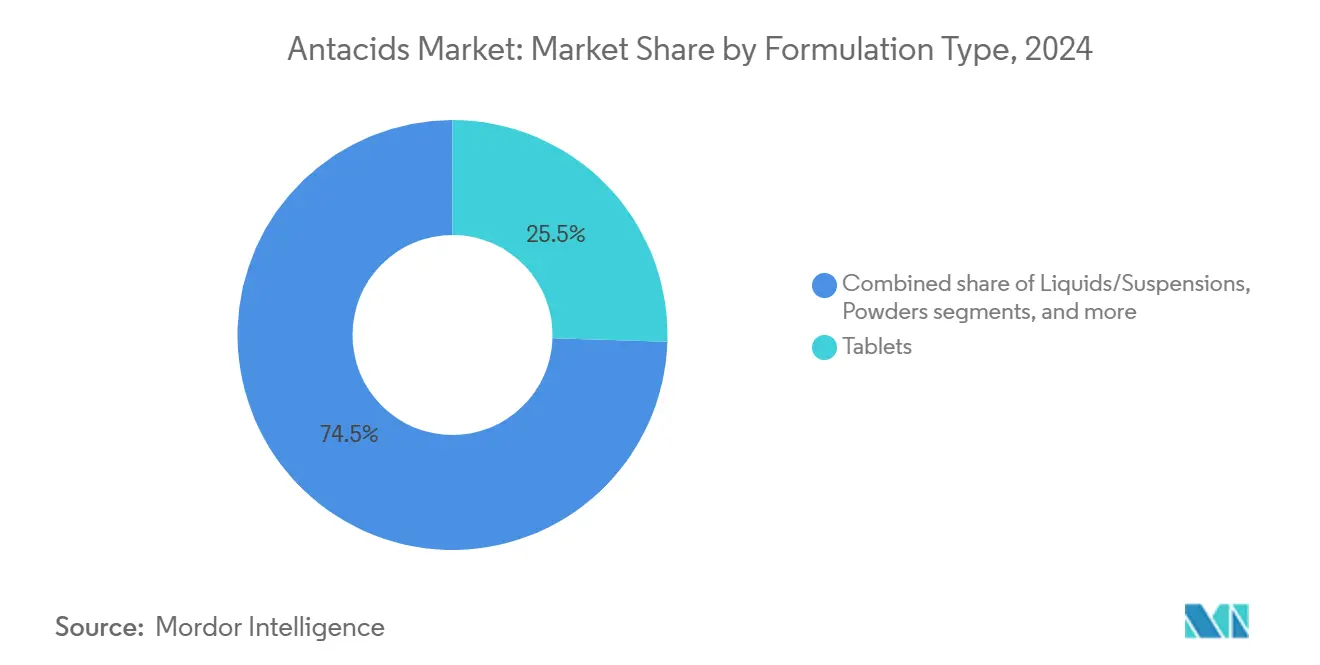
Note: Segment shares of all individual segments available upon report purchase
By Active Ingredient Type: Alginate Innovation Reshapes Market
Calcium carbonate anchored 38.54% of the antacids market size in 2024, favored for its dual role in neutralizing acid and supplementing calcium intake. Yet alginate-based systems are expanding fastest at a 5.23% CAGR, drawing clinical support for their raft-forming barrier that prevents reflux episodes without systemic absorption. Gaviscon’s alginate platform has demonstrated lower esophageal acid exposure and improved nighttime symptom control versus magnesium-aluminum blends. Combination therapies pair alginates with simethicone to tackle gas and acid in one dose, reinforcing adherence.
Magnesium hydroxide and oxide deliver rapid pH elevation but carry laxative effects that curb chronic use. Aluminum compounds are losing favor over neurologic safety worries, especially in renal-compromised seniors. Sodium bicarbonate retains emergency-room relevance for acute hyperacidity owing to its immediate neutralization but high sodium load restricts home use. Recent prototypes fuse magnesium alginate with proton pump micro-granules, offering immediate and prolonged relief in a single chewable tablet. This layered approach typifies the innovation race within the antacids market.
By Indication: GERD Dominance Faces Heartburn Challenge
GERD generated 49.23% revenue in 2024, cementing its role as the anchor indication, but episodic heartburn is gaining traction with a 5.76% CAGR. Consumers with lifestyle-triggered symptoms view antacids as first-line tools for on-demand relief, fueling sales of pocket-sized roll packs and single-serve sachets. Peptic ulcer therapy is shifting toward PPIs for mucosal healing, relegating antacids to adjunct status. Functional dyspepsia, characterized by early satiety and bloating, opens space for hybrid formulations that combine antacid, prokinetic, and carminative actions, mirroring multi-symptom over-the-counter cold remedies.
Diabetic gastroparesis presents an emerging arena: 56% of diabetic patients report early satiety, a driver that intersects reflux management and glycemic control strategies. Stress gastritis in intensive care units and medication-induced dyspepsia in polypharmacy patients add niche demand streams. Segment-specific branding—“nighttime GERD,” “pregnancy heartburn,” or “spicy-food rescue”—is shaping shelf organization, signaling how granular indication targeting is evolving across the antacids market.
By Route of Administration: Oral Solid Maintains Dominance
Oral solids covered 64.44% of antacids market share in 2024, largely because tablets and capsules offer long shelf life, lower freight costs, and accurate dose uniformity. Yet oral liquids are projected to rise at a 6.12% CAGR, propelled by pleasant flavor systems and child-friendly dosing cups. Suspension technology has advanced to maintain uniform active distribution for up to 24 months, minimizing sedimentation. Quick-dissolve powders that convert to foaming drinks on contact with water bring theater to dosing and can mask after-tastes that deter repeat purchase.
Hybrid innovations such as effervescent tablets deliver a liquid experience without baggage weight, expanding travel retail sales. pH-buffered omeprazole suspensions showcase how liquid formats can handle previously unstable actives, challenging older assumptions about formulation limits. As aging populations confront dysphagia, hospitals and extended-care facilities are stocking more ready-to-drink pouches, encouraging suppliers to develop aseptic filling lines compatible with viscous antacid gels. Nonetheless, cost advantages give solids a firm footing, ensuring they will remain a mainstay in the antacids market through 2030.
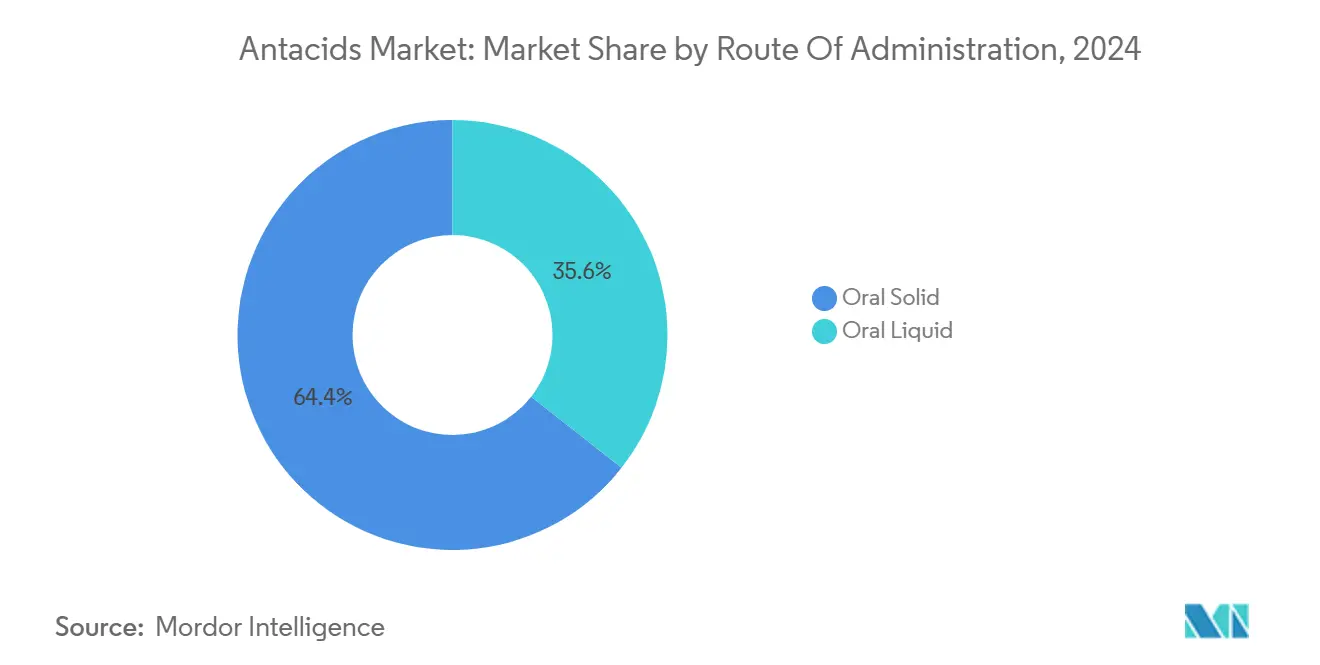
Note: Segment shares of all individual segments available upon report purchase
By Distribution Channel: Retail Pharmacy Consolidation Accelerates
Retail pharmacies and drug stores retained a 44.67% share in 2024 and will grow fastest at 6.55% CAGR, underscoring their clout as both dispensers and health-advice hubs. Chain consolidation enhances shelf standardization and category management, making high-velocity antacid SKUs easier to locate. Simultaneously, pharmacy mobile apps allow click-and-collect service—patients order via smartphone and pick up within an hour—blending immediacy with convenience. Hospital pharmacies cater to acute-care and post-operative reflux management but occupy a smaller slice of overall volume because most antacid purchases remain consumer-driven and preventive.
E-commerce platforms account for an expanding share of under-30 purchases, with algorithmic promotions pushing subscription models that lock in monthly refill revenue. Mass merchandisers and convenience stores focus on impulse buys—single-dose sachets near beverage coolers target consumers seeking rapid relief after spicy or high-fat meals. The regulatory acceptance of digital labeling, approved by the FDA in 2025, will next enable QR code links to full monograph data, reinforcing the retail pharmacy channel’s role as both a physical and virtual knowledge base within the antacids market.
Geography Analysis
North America commanded 42.45% of antacids market revenue in 2024, anchored by high disposable incomes, strong self-medication culture, and well-established pharmacy chains. Widespread direct-to-consumer advertising keeps brand awareness high, while prescription-to-OTC switches introduce advanced agents that maintain consumer loyalty within the category. The United States also hosts many innovation centers, as evidenced by Sun Pharmaceutical’s USD 100 million R&D expansion in New Jersey aimed at speeding specialty generic launches. Canadian demand aligns closely with U.S. trends, though provincial reimbursement policies add regional nuances in brand selection.
Europe presents a contrasting maturity scenario. Strict Health Technology Assessment (HTA) processes and price referencing apply downward pressure on retail margins, yet sustained GERD prevalence upholds baseline volume. Environmental priorities spur demand for plant-based actives and recyclable packaging, encouraging local suppliers to differentiate on sustainability credentials. France and Germany remain prescription-heavy markets, but Italy and Spain exhibit higher OTC penetration due to differing insurance co-payment structures. Regulatory recalibration, such as the European Union’s ongoing evaluation of aluminum exposure limits, could redirect product development toward low-aluminum alternatives.
Asia-Pacific is the momentum story, projected at a 4.56% CAGR—well above the global average. Rising middle-class purchasing power and dietary westernization in India, Indonesia, and the Philippines feed demand for convenient reflux remedies. Market-entry barriers are easing as governments streamline OTC registration to widen access to primary care substitutes. Public–private collaborations, exemplified by India’s Ayushman Bharat digital health initiative, integrate teleconsultation and e-pharmacy services, weaving antacids into chronic-disease management bundles. Japan, already a high-consumer but aging market, is shifting to P-CAB therapies, yet still ranks among the top per-capita purchasers of alginate products.
The Middle East and Africa hold modest share but offer rising opportunity as healthcare infrastructure improves. Gulf Cooperation Council states import premium antacid brands to satisfy expatriate populations, while Nigeria and Kenya exhibit grassroots growth in sachet-sized calcium carbonate powders sold through informal kiosks. South America occupies an intermediate position; Brazil’s domestic manufacturing base supports competitively priced generics, whereas Argentina’s inflation volatility affects stocking decisions at pharmacy chains. Across all developing regions, mobile-first e-commerce provides rural communities with access to branded antacids market products previously confined to urban centers.
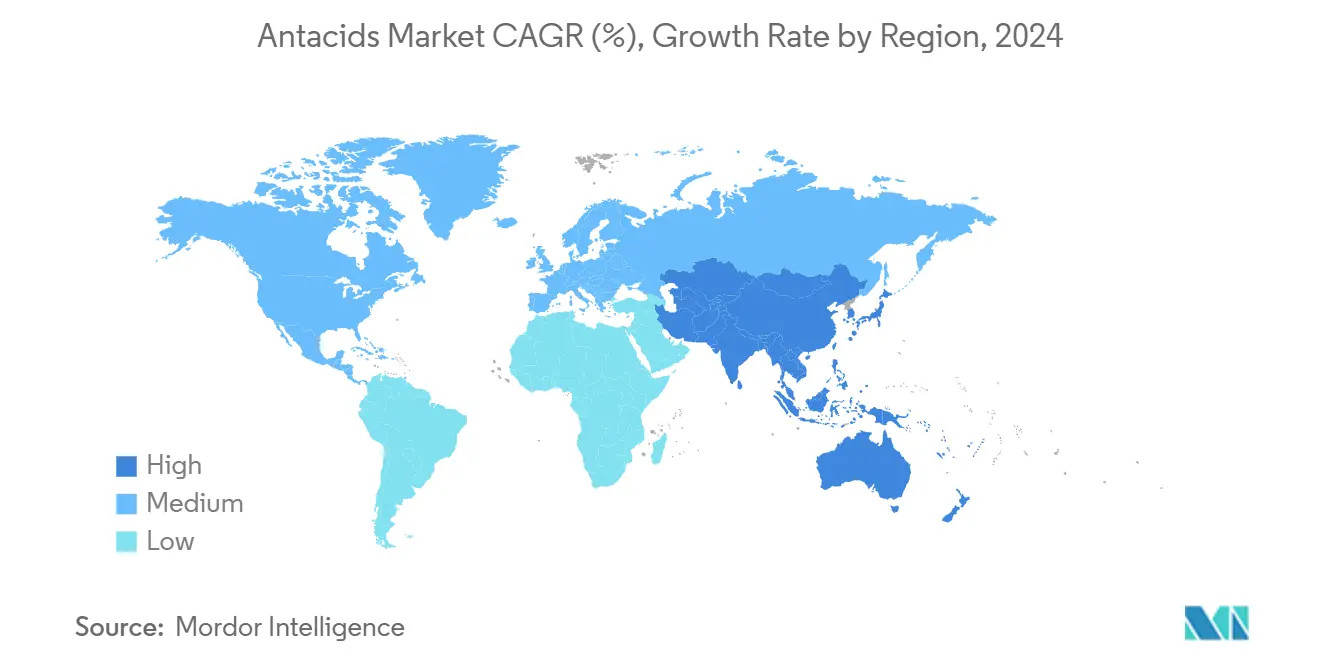
Competitive Landscape
The antacids market is moderately fragmented, balancing the scale advantages of multinational corporations against regional challengers that exploit local consumer insight and cost structures. Haleon, caretaker of the Gaviscon franchise, reported 6.1% organic revenue growth for its digestive-health “Power Brands” segment in Q3 2024, underscoring the resilience of trusted heritage lines. Reckitt Benckiser continues to prune its portfolio to sharpen focus on core assets such as Gaviscon, using premium in-store merchandising to justify pricing headroom. Johnson & Johnson maintains reach via Mylanta in North America and parts of Asia, pairing antacid-antigas formulations to capture multi-symptom shoppers.
Disruptors bring niche positioning. Wonderbelly, a U.S. startup, markets aluminum-free chewable tablets with clean-label claims and direct-to-consumer shipping, attracting ethically minded millennials. Phathom Pharmaceuticals has blurred category boundaries with VOQUEZNA (vonoprazan), the first new GERD class in three decades, now seeking OTC viability—a move that could redraw competitive maps. At the regional level, Dr. Reddy’s and Cipla leverage large domestic networks in India to deliver private-label calcium carbonate–magnesium combinations at aggressive price points.
Strategic moves center on formulation science and channel alliances rather than pure price undercutting. Haleon signed supply agreements with leading e-pharmacies across Southeast Asia to guarantee 24-hour delivery windows. Reckitt invested in sensory-science labs in the United Kingdom to accelerate flavor-masking breakthroughs in gummy formats. Sun Pharmaceutical’s expanded U.S. hub targets rapid ANDA filings for alginate-based generics. Meanwhile, private-equity interest is rising: several funds are scouting mid-tier manufacturers in Eastern Europe as acquisition targets to build roll-up platforms, betting on stable cash flows from OTC digestive remedies. Those maneuvers collectively keep competitive tension high and spur continuous innovation across the antacids market.
Antacids Industry Leaders
-
Sanofi S.A
-
Bayer AG
-
Johnson & Johnson
-
Haleon Plc
-
Sun Pharmaceutical Industries Ltd.
- *Disclaimer: Major Players sorted in no particular order
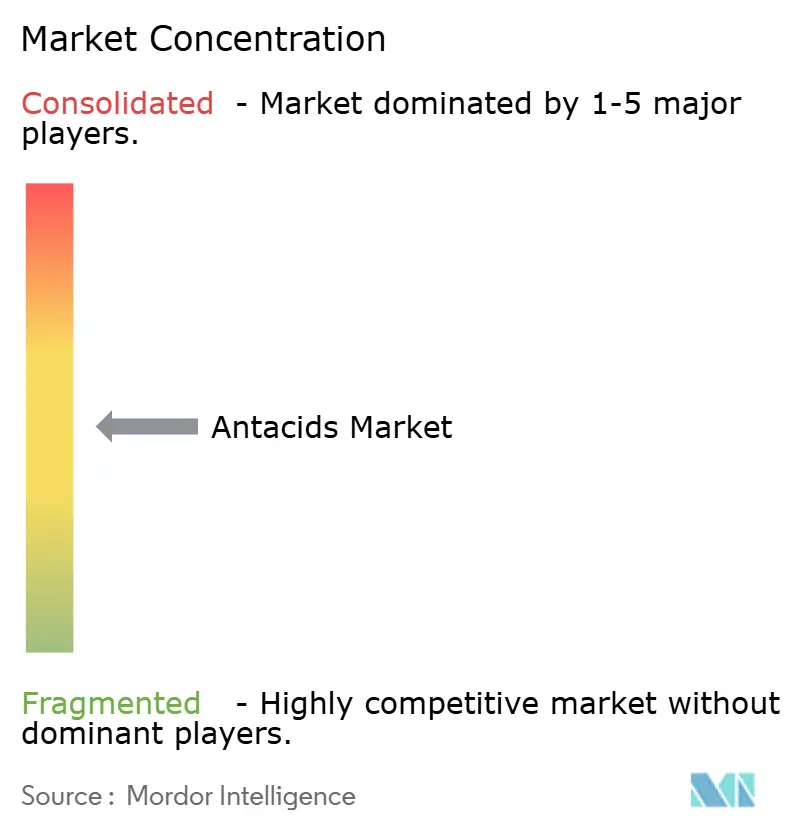
Recent Industry Developments
- June 2025: FDA issued draft guidance allowing minor OTC monograph changes that let manufacturers shift tablet formats to chewables or films without separate orders, speeding formulation refresh cycles.
- April 2025: GSK agreed to a USD 2.2 billion settlement covering 93% of Zantac litigation, reducing legal risk clouds over the broader antacids category.
- April 2025: Sebela Pharmaceuticals announced positive Phase 3 data for tegoprazan, a P-CAB demonstrating superiority to lansoprazole, with FDA submission planned for Q4 2025.
- March 2025: Eisai obtained approval for OTC rabeprazole (Pariet S) in Japan, widening consumer access to once-daily acid suppression.
- March 2025: Sun Pharmaceutical revealed a USD 100 million headquarters expansion in New Jersey, adding 220 R&D jobs and elevating its specialty generics pipeline.
Research Methodology Framework and Report Scope
Market Definitions and Key Coverage
Our study defines the global antacids market as the retail and hospital sales value of over-the-counter or pharmacist-dispensed preparations that chemically neutralize gastric acid, including calcium carbonate, magnesium and aluminum compounds, sodium bicarbonate, alginate blends, and fixed-dose combinations. Preparations sold purely as proton pump inhibitors, H2 blockers, digestive enzymes, or herbal remedies sit outside this definition, even when consumers use them for similar symptoms.
Scope Exclusions: Intravenous antacid infusions, compounded pharmacy mixtures, and prescription-only PPIs or H2 antagonists are excluded.
Segmentation Overview
- By Formulation Type
- Tablets
- Liquids / Suspensions
- Powders
- Gummies / Chewable Soft-Gels
- Effervescent Granules
- Other Formulations
- By Active Ingredient Type
- Calcium Carbonate
- Magnesium Compounds
- Aluminium Compounds
- Sodium Bicarbonate
- Alginate-Based
- Combination Preparations
- By Indication
- Heartburn
- Gastroesophageal Reflux Disease (GERD)
- Peptic Ulcer
- Functional Dyspepsia
- Other Acid-Related Disorders
- By Route Of Administration
- Oral Solid
- Oral Liquid
- By Distribution Channel
- Hospital Pharmacies
- Retail Pharmacies & Drug Stores
- E-Commerce
- Other Channels
- Geography
- North America
- United States
- Canada
- Mexico
- Europe
- Germany
- United Kingdom
- France
- Italy
- Spain
- Rest of Europe
- Asia-Pacific
- China
- Japan
- India
- Australia
- South Korea
- Rest of Asia-Pacific
- Middle East & Africa
- GCC
- South Africa
- Rest of Middle East & Africa
- South America
- Brazil
- Argentina
- Rest of South America
- GCC
- North America
Detailed Research Methodology and Data Validation
Primary Research
Interviews and structured surveys with community pharmacists, gastroenterologists, procurement heads, and bulk ingredient suppliers across North America, Europe, and Asia-Pacific validated average selling prices, pack size shifts, and uptake of chewable gels. These conversations also flagged emerging demand from online pharmacies that is not yet visible in public datasets.
Desk Research
We began with publicly available macro and disease data from sources such as the World Health Organization, the Centers for Disease Control and Prevention, Eurostat, and national medicine sales portals, which help us gauge reflux prevalence, self-medication rates, and pharmacy channel mix. Company filings, FDA Orange Book listings, and trade association releases on antacid shipments provided price benchmarks and competitive shares. Paid repositories like D&B Hoovers and Dow Jones Factiva allowed our analysts to cross-check corporate revenues and news flow for volume surges after product launches. The sources named are illustrative, and many additional publications supported data gathering and sense-checking.
Market-Sizing & Forecasting
A top-down build starts with country-level OTC drug expenditure, reflux prevalence, and antacid purchase incidence, which are then multiplied to derive demand pools. Selective bottom-up checks, such as supplier shipment roll-ups and sampled carton price × volume math, anchor the totals. Key inputs include adult GERD prevalence, per capita retail pharmacy density, average calcium carbonate price, e-commerce penetration in OTC drugs, and disposable income growth. Multivariate regression links these drivers to historical sales and generates the base forecast; scenario analysis adjusts for regulatory alerts or raw-material cost shocks. Gaps in shipment data are bridged by triangulating pharmacist reorder frequencies with ingredient import statistics.
Data Validation & Update Cycle
Outputs pass automated variance scans, peer review, and a senior analyst sign-off. According to Mordor Intelligence, every model refreshes yearly, and interim updates trigger when recalls, tax changes, or supply disruptions shift the market narrative.
Why Mordor's Antacids Baseline Earns Decision-Maker Confidence
Published figures often diverge because publishers bundle PPIs with antacids, apply uniform average prices, or freeze assumptions for years.
Our team filters only neutralizing agents, refreshes prices each quarter, and balances top-down prevalence math with supplier reality checks, which is where Mordor Intelligence differentiates.
Benchmark comparison
| Market Size | Anonymized source | Primary gap driver |
|---|---|---|
| USD 7.06 B (2025) | Mordor Intelligence | - |
| USD 7.10 B (2023) | Global Consultancy A | Includes prescription PPIs and relies on historic currency rates |
| USD 7.44 B (2024) | Industry Data Firm B | Uses constant ASP across regions and omits online channel growth |
| USD 9.63 B (2024) | Trade Publication C | Aggregates digestive aids, creating a broader scope than antacids |
In sum, the comparison shows that numbers swing with scope, price, and refresh cadence. Mordor's disciplined variable selection and annual model review give clients a clear, reproducible baseline they can trust for planning and investment.
Key Questions Answered in the Report
What is the current value of the antacids market?
The antacids market stands at USD 7.06 billion in 2025 and is on course to reach USD 8.35 billion by 2030.
Which formulation type is growing fastest?
Gummies and chewable soft-gels are expanding at a 5.67% CAGR, the highest among all formulation categories.
Why are alginate-based antacids gaining popularity?
Alginate products form a physical raft that blocks reflux, delivering longer relief without systemic absorption, which fuels their 5.23% CAGR growth.
Which region will contribute the most incremental sales by 2030?
Asia-Pacific, forecast at a 4.56% CAGR, will add the largest volume of new sales due to rising healthcare spending and dietary westernization.
How are regulatory changes affecting market dynamics?
FDA’s ACNU rule and similar frameworks abroad now allow faster prescription-to-OTC switches, bringing advanced acid suppressants into retail channels and intensifying competition.
What safety issues should chronic users of antacids consider?
Long-term use can alter mineral absorption and, in past cases such as ranitidine, has raised contamination concerns, underscoring the need for periodic medical review.
Page last updated on:
